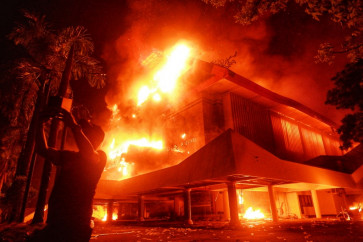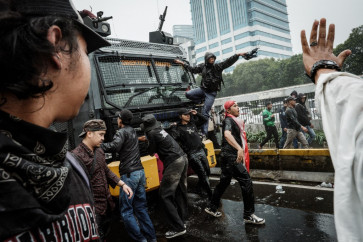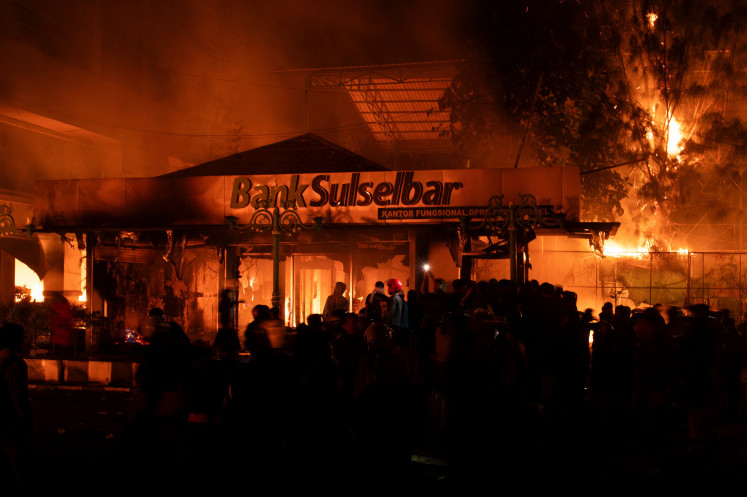Popular Reads
Top Results
Can't find what you're looking for?
View all search resultsPopular Reads
Top Results
Can't find what you're looking for?
View all search resultsHeri Dono: Globalization, Trojan horses and the Venice Biennale
âVoyageâ: Artist Heri Dono (left) poses with guests in front of his âVoyageâ exhibit
Change text size
Gift Premium Articles
to Anyone
'Voyage': Artist Heri Dono (left) poses with guests in front of his 'Voyage' exhibit.
Heri Dono is ready to reflect on colonialism, globalism and cultural differences at an exhibition at the 56th Venice Biennale, one of the world's most prestigious contemporary art exhibitions.
One of Dono's pieces, Trokomod ' a portmanteau of Trojan Horse and Komodo ' is a 4-meter-tall ship in the shape of a Komodo dragon. It can fit up to eight visitors, who can take a look at some of Western artifacts from periscope-cannons, such as a statue of a man in a white curly horse-hair wig.
It is also made from rusty iron as a critique on the Western extraction of gold in Papua.
Under the overall name of 'Voyage', the pieces on display will also feature a fleet of Perahu Arwah (Boats of the Departed Spirits) with wings and propellers that sail above Trokomod.
'Voyage' is Dono's reflection on the connections between globalization and local culture, covering the spice trade, which brought European colonists to the archipelago; Indonesia's independence era (the work features Sukarno speaking at the UN); the nation's present struggles and even the French satirical magazine Charlie Hebdo.
'Voyage' is part of Dono's quest to introduce Indonesian art to the global arena, according to Dono.
'In the global art scene, Indonesia has always been a blank spot - it is never talked about. It has been suggested that Indonesia is represented by Chinese contemporary arts,' he says. 'I believe it is a big mistake.'
'[Voyage] speaks about our perceptual differences with the West, and also criticizes Western hegemony of the global contemporary art. We want to be seen as equal,' Dono says about the work that he crafted along with dozens of architects and local artisans from Bandung, West Java and his base, Yogyakarta.
His production team is led by producer and artistic director Restu Imansari Kusumaningrum.
'Voyage' will fill 300 square meters of the Indonesia National Pavilion at the Arsenale, the complex of former shipyards that is one of the two main venues of the biennale, which will run from May 9 to Nov. 22.
Close up: A close-up of Dono's Trokomod (right) as one of his 'Perahu Arwah' hangs from above.
Dono will be the only artist to be featured at the Indonesian pavilion, which is supported by Bumi Purnati Indonesia and the Tourism Ministry, following its debut in 2013, when it showcased the works of five Indonesian artists.
Since becoming the first Indonesian artist to break into the global contemporary art scene in the 1990s, Dono has received numerous awards, including a UNESCO Prize at the International Art Biennale in Shanghai (2000) and the Netherlands' Prince Claus Awards (1998).
Dono has participated in 27 international biennales and scores of high-profile exhibitions, in addition to residencies in Switzerland, the UK, Australia, Germany and the US.
One may not suspect that Dono, behind a calm and friendly demeanor, has used his paintings, installations, sculptures and performances to deliver messages about injustice, oppression, dictatorship and environmental issues.
His art combines animation, cartoons and Hindu Javanese culture, in particular wayang puppet theater. Angels, incongruous creatures and wayang characters are his media for making sociopolitical commentary with humor and satire.
'As an artist, I feel like a wayang puppet. Sometimes my conscience cannot wholly understand myself. I am just a part of sociopolitical system where I become like Pinocchio ' controlled but still attempting to be human,' Dono said.
Born in 1960 and raised in Jakarta, Dono moved to Yogyakarta in 1980 to study painting at the Indonesian Arts Institute. After seven years, he dropped out and turned to mastering wayang with Ki Sukasman, a puppet master (dalang) who created Wayang Ukur.
'Prior to dropping out, I came to Sukasman's place and learned that wayang was much more modern compared to the art of painting that I had learned,' he said. 'Wayang is based on culture ' in particular Javanese culture ' and does not segregate art disciplines. In wayang, there is theater, music, dance and literature.'
His critiques on the nation's sociopolitical problems led the government to watch over him during Soeharto's New Order.
Meeting the creator: An artist's talk in front of Heri Dono's 'Voyage' exhibit.
For example, in 1996, prior to Dono's exhibition 'Blooming in Arms' at Museum of Modern Art in Oxford, the Indonesian embassy in London requested that the museum withdraw the exhibition catalog.
'Blooming in Arms' contrasted a government program encouraging citizens to plant trees with another policy of allowing multinational firms to deforest Sumatra, Kalimantan and Papua.
In a performance titled 'Drunkeness of Semar', Dono wittily explored the impact of modernization and militarism on society, as David Elliot and Gilane Tawadros said in the catalog.
'When I got back from England, I was interrogated for two days at the police station,' Dono said.
While his style is often described as New Internationalism, Dono refuses to be classified.
'I have disassociated myself from such 'isms',' Dono says. I'm more into glocal ' the 'global local'. The focus is to respect the local while anticipating trends on the global art scene.'
After the biennale, Dono is slated for exhibitions in Tokyo, Singapore and Jakarta, a one-month residency in Los Angeles and to give lectures in Berlin.
Beyond fame and admiration from art lovers around the globe, Heri Dono is humble man, with a selfless dream.
'My ambition is to become the mediator on art issues in Indonesia. I want every regions of Indonesia to have art academies, so I can talk about art in Papua and Sulawesi. I can't do that now. I once came there and they asked 'What is contemporary art, mas?' It makes me feel sad,' he says.
Portrait of the artist: Heri Dono speaks at an artist's talk.













